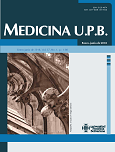Proteinuria persistente en pacientes pediátricos, caracterización histopatológica y su influencia en la progresión de la enfermedad renal crónica
Contenido principal del artículo
Resumen
Objetivo: describir los hallazgos histopatológicos y la progresión a enfermedad renal crónica de los pacientes sometidos a biopsia renal en un hospital de referencia de la ciudad de Medellín entre 2005 y 2014.
Metodología: estudio descriptivo retrospectivo. Se revisaron historias clínicas de pacientes menores de 18 años con diagnóstico de proteinuria persistente, a quienes se les realizó biopsia renal durante el período 2005-2014 en el Hospital Pablo Tobón Uribe. Se analizaron variables sociodemográficas, clínicas, histológicas y de laboratorio.
Resultados: se incluyeron 71 pacientes. La edad promedio del diagnóstico de proteinuria persistente fue 10.07 años. El 69.1% y 20.6% de los pacientes presentaron hematuria e hipertensión arterial respectivamente. La glomerulonefritis por IgA fue el hallazgo histológico más frecuente (21.13%), seguido de la nefropatía lúpica (18.31%). Del total de pacientes, 69.0% recibieron inhibidores de la enzima convertidora de angiotensina y el 15.9% presentaron deterioro de la función renal al cuarto año de seguimiento.
Conclusiones: la prevalencia de glomerulopatías en niños con proteinuria persistente fue alta. Se sugiere la realización de la biopsia renal con el fin de detectar tempranamente glomerulopatías primarias o secundarias asociadas para así instaurar un tratamiento oportuno que controle o retarde el deterioro de la función renal.
Referencias
Hogg RJ, Portman RJ, Milliner D, Lemley K V., Eddy A, Ingelfinger J. Evaluation and management of proteinuria and nephrotic syndrome in children: Recommendations from a pediatric nephrology panel established at the National Kidney Foundation Conference on Proteinuria, Albuminuria, Risk, Assessment, Detection, and Eliminati. Pediatrics 2005;105(6):1242–1249.
Pais P, Avner ED. Nelson Textbook of Pediatrics. Nineteenth. Conditions Particularly Associated With Proteinuria. Elsevier; 2011. 1799-1800.e1 p.
Lunn A, Forbes T. Haematuria and proteinuria in childhood. Paediatr Child Health (Oxford) [Internet]. Elsevier Ltd; 2012 Aug [cited 2014 Dec 1];22(8):315–21. Available from: http:// linkinghub.elsevier.com/retrieve/pii/S1751722212000303
Park Y-H, Choi J-Y, Chung H-S, Koo J-W, Kim S-Y, Namgoong M-K, et al. Hematuria and proteinuria in a mass school urine screening test. Pediatr Nephrol [Internet]. 2005 Aug [cited 2014 Dec 1];20(8):1126–30. Available from: http://www.ncbi.nlm.nih.gov/pubmed/15947990
Hirano D, Fujinaga S, Shinozaki T, Endo A, Watanabe T, Murakami H, et al. Optimal urinary protein-to-creatinine ratio as a renal biopsy criterion in children with asymptomatic proteinuria. Clin Nephrol [Internet]. 2014;82(8):115–21. Available from: http://www.dustri.com/article_ response_page.html?artId=11633&doi=10.5414/CN108276&L=0
Srivastava RN. Isolated asymptomatic proteinuria. Indian J Pediatr. 2002;69(12):1055–8.
Kashif W, Siddiqi N, Dincer A, Dincer H, Hirsch S. Proteinuria: How to evaluate an important finding. Cleve Clin J Med 2003;70(6):535–537.
Kallen ARJ, Langman CB. Pediatric Proteinuria. Medscape Ref. 2013;3–9.
Okpere N, Anochie IC, Eke FU. Prevalence of microalbuminuria among secondary school children. Afr Health Sci 2012;12(2):140–147.
Ruggenenti P, Perna A, Mosconi L, Pisoni R, Remuzzi G. Urinary protein excretion rate is the best independent predictor of ESRF in non-diabetic proteinuric chronic nephropathies. Kidney Int 1998;53(5):1209–1216.
Christian MT, Watson AR. The investigation of proteinuria. Curr Paediatr 2004;14(7):547–555.
Raffaelli RM, Pradhan M. Hematuria and proteinuria. In: Nelson Textbook of Pediatrics [Internet]. Elsevier; 2011 [cited 2014 Dec 1]. p. 372–9. Available from: http://dx.doi.org/10.1016/B978-1- 4377-1155-4.00061-4
Marsciani M, Pasini A, Montini G. Proteinuria asintomatica. Nel Bambino 2011;28(5):489–498.
Lee Y-M, Baek S-Y, Kim JH, Kim DS, Lee JS, Kim P-K. Analysis of renal biopsies performed in children with abnormal findings in urinary mass screening. Acta Paediatr 2006;95(7):849–853.
Mundi I, Cruz SD, Punia RPS, Kaur R, Sachdev A. Clinico-pathological study of glomerular diseases in patients with significant proteinuria in North India. Saudi J Kidney Dis Transpl 2014;25(2):443–449.
Orta N, Coronel V, Lara E, Escalona B, Zibaoui P, Peralta C, et al. Hematuria and Proteinuria. Arch Venez Pueric Pediatr 2009;72(4):123–128.
Arias L, Henao J, Giraldo R, Carvajal N, Rodelo J, Arbeláez M. Glomerular diseases in a Hispanic population: Review of a regional renal biopsy database. Sao Paulo Med J 2009;127(3):140–144.
Rocha LP, Carminati CR, MacHado JR, Laterza VL, Dos Reis MA, Corrêa RRM. Prevalence of nephropathies in children and adolescents and alterations in renal biopsies in Minas Gerais, Brazil, from 1996 to 2010. Ann Diagn Pathol [Internet]. Elsevier Inc.; 2013;17(1):22–7. Available from: http://dx.doi.org/10.1016/j.anndiagpath.2012.04.006
Zhai Y, Xu H, Shen Q, Cao Q, Zhu G, Wei M, et al. Renal histological features of school-age children with asymptomatic haematuria and/or proteinuria: A multicenter study. Nephrology 2014;19(7):426–431.
Keane W, Eknoyan G. Proteinuria, albuminuria, risk, assessment, detection, elimination (PARADE): A position paper of the National Kidney Foundation. Am J Kidney Dis 1999;33(5):1004–1010.
Coppo R. How early renal biopsy has to be performed in children with isolated asymptomatic proteinuria? Nephrol Dial Transplant [Internet]. 2012;27(8):3016–7. Available from: http://ndt. oxfordjournals.org/cgi/doi/10.1093/ndt/gfs147
Noone D, Licht C. Chronic kidney disease: a new look at pathogenetic mechanisms and treatment options. Pediatr Nephrol 2014;29(5):779–92.
Soergel M, Verho M, Wühl E, Gellermann J, Teichert L, Schärer K. Effect of ramipril on ambulatory blood pressure and albuminuria in renal hypertension. Pediatr Nephrol 2000;15:113–118.
Webb NJ, Shahinfar S, Wells TG, Massaad R, Gleim GW, Sisk CM, et al. Losartan and enalapril are comparable in reducing proteinuria in children with Alport syndrome. Pediatr Nephrol 2013;28(5):737–743.
Hari P, Sahu J, Sinha A, Mohan Pandey R, Shekhar C, Bagga A. Effect of enalapril on glomerular filtration rate and proteinuria in children with chronic kidney disease: Indian Pediatr 2013;50:923– 928.


